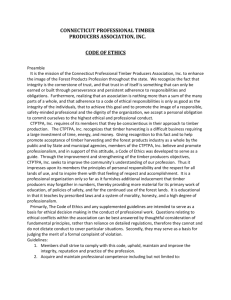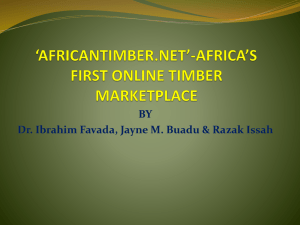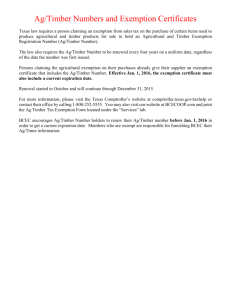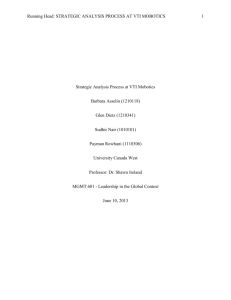FingerprintingProgressNote
advertisement
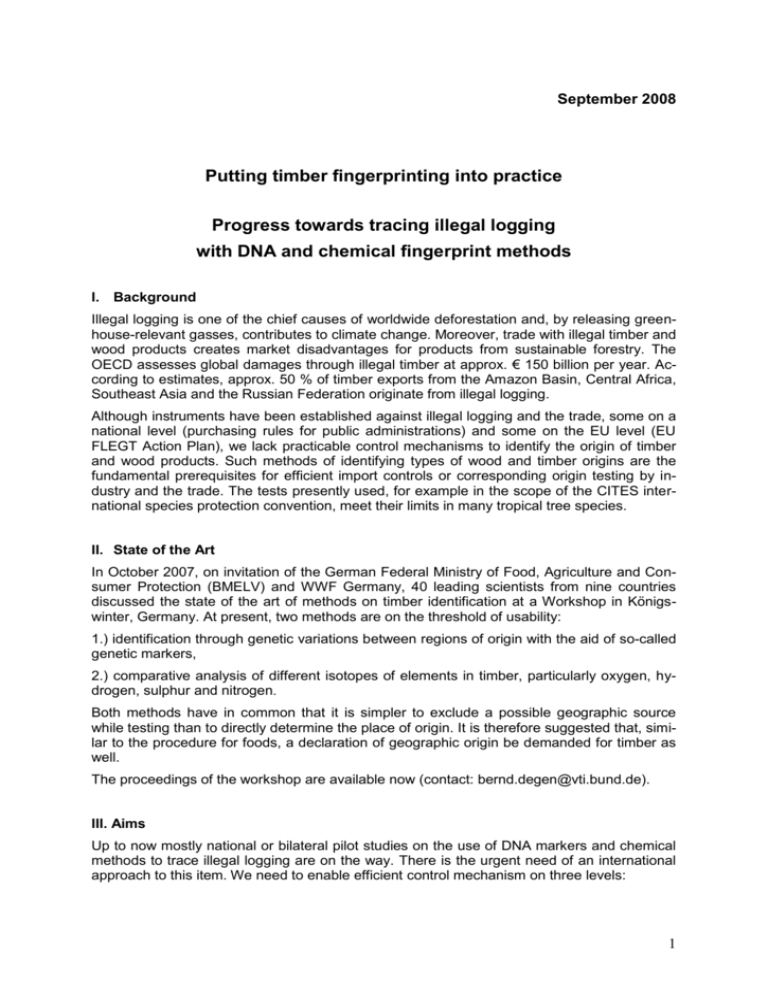
September 2008 Putting timber fingerprinting into practice Progress towards tracing illegal logging with DNA and chemical fingerprint methods I. Background Illegal logging is one of the chief causes of worldwide deforestation and, by releasing greenhouse-relevant gasses, contributes to climate change. Moreover, trade with illegal timber and wood products creates market disadvantages for products from sustainable forestry. The OECD assesses global damages through illegal timber at approx. € 150 billion per year. According to estimates, approx. 50 % of timber exports from the Amazon Basin, Central Africa, Southeast Asia and the Russian Federation originate from illegal logging. Although instruments have been established against illegal logging and the trade, some on a national level (purchasing rules for public administrations) and some on the EU level (EU FLEGT Action Plan), we lack practicable control mechanisms to identify the origin of timber and wood products. Such methods of identifying types of wood and timber origins are the fundamental prerequisites for efficient import controls or corresponding origin testing by industry and the trade. The tests presently used, for example in the scope of the CITES international species protection convention, meet their limits in many tropical tree species. II. State of the Art In October 2007, on invitation of the German Federal Ministry of Food, Agriculture and Consumer Protection (BMELV) and WWF Germany, 40 leading scientists from nine countries discussed the state of the art of methods on timber identification at a Workshop in Königswinter, Germany. At present, two methods are on the threshold of usability: 1.) identification through genetic variations between regions of origin with the aid of so-called genetic markers, 2.) comparative analysis of different isotopes of elements in timber, particularly oxygen, hydrogen, sulphur and nitrogen. Both methods have in common that it is simpler to exclude a possible geographic source while testing than to directly determine the place of origin. It is therefore suggested that, similar to the procedure for foods, a declaration of geographic origin be demanded for timber as well. The proceedings of the workshop are available now (contact: bernd.degen@vti.bund.de). III. Aims Up to now mostly national or bilateral pilot studies on the use of DNA markers and chemical methods to trace illegal logging are on the way. There is the urgent need of an international approach to this item. We need to enable efficient control mechanism on three levels: 1 A) Species identification It is relatively common for tropical producer countries to prohibit the logging or export of certain species in certain forms. The Convention on International Trade in Endangered Species (CITES) has also the objective to protect a set of endangered tree species. CITES controls seldom ban trade entirely, but do require that special legal documents be presented at export and import. A common way in which criminal traders seek to circumvent CITES controls is by providing a false declaration of the species involved. The computer-based programme CITESwoodID developed by vTI (formerly BFH) in Hamburg offers a sophisticated tool for macroscopic identification. It is being continuously further improved. But in the case of many mainly tropical alike species this method has its limits and genetic methods to control species identity would be needed to complement it. B) Control of the country of origin of timber The falsification of the country of origin is another well-documented area of illegality in the trade in tropical timber. This occurs at the point of import for timber that is in international trade, and usually involves the production of false paperwork such as phytosanitary certificates, invoices and certificates of origin. An actual example is the ban of the EU and the USA on teak from Birma (Myanmar). Improved control methods of the geographic origin of timber thus is another important issue. C) Control the geographic origin of timber on a regional scale within countries Another common problem of illegal logging on smaller spatial scales is the false declaration of timber that has been logged outside a registered concession, or within a protected area. On this scale certified forest companies might have an economic interest to apply genetic or chemical fingerprints to proof their efforts of sustainable forest management. International standards for sampling, DNA extractions and genotype nomenclature as well as openly accessible databanks are further features of such an international approach. IV) Progress since October 2007 vTI in Hamburg (see contact below) has been tasked to act as coordinator for follow up work, networking and preparing ground for an international project. International consolidation of list of 10 priority species for identification of origin and a list of 60 for species identification has been accomplished. Project 2008-2011 (started) on identification of species and origins of American mahogany (Swietenia humilis, S. mahagoni, S. macrophylla) through genetic markers, taking alike species Khaya spp. and Entandrophragma spp. into account (vTI, international partners in USA, UK, and countries of origin (e.g. Brazil, Costa Rica) as well as private sector). Project 2008-20010 (started) on identification of origins of Teak and Mahogany (same as above) through isotope analysis, extension to genetic markers planned (Agroisolab, WWF, vTI and international partners) Project 2008-2011 (planned and predecided) on identification of origins of Merbau (Intsia bijuga, I. moeleri, I. palembanica). 2 Project (recommended for EU-co-funding, possibly starting in 2008/09-2010) on control of origin from concession sources in Cameroon (GTZ, vTI, TFT, envisaged: Agroisolab, private sector) Project on barcoding (species identification) of 20 tropical CITES timber species. (waiting for approval, University Hamburg with vTI) EUREKA-Project on comparing different methods (greater context), incl. genetic and isotope analysis but also genetic markers of bacteria and infrared technology (in preparation, EU-partners with vTI). Further improvement of CITESwoodID (see above) and intensified ongoing work at vTI on macroscopic and microscopic analyses of traded timber with unclear origin or species identification (344 cases 2007) on requests from customs/CITES authorities but increasingly also from private sector (discounter, retailers, timber industry). V) Next steps As envisaged in Königswinter 2007, an international project is needed to cover all the priority species and coordinate ongoing work at different places. Initial networking has been accomplished. Institutes in England, France, Italy, Australia, USA have already signalled their interest. Talks with international organisations and further potential donors are ongoing. If you are interested in more detailed information or active involvement please contact: Scientific Coordinator: Dr. Bernd Degen Institute for Forest Genetics Sieker Landstr. 2, 22927 Großhansdorf, Germany Tel.: +49-4102-696101 FAX: +49-4102-696200 E-Mail: bernd.degen@vti.bund.de Governmental focal point: Matthias Schwoerer Head of international forest policy division Federal Ministry of Agriculture, Food and Consumer Protection Rochusstr. 1, 53123 Bonn, Germany Tel.: +49-228-5293348 E-Mail: matthias.schwoerer@bmelv.bund.de 3



